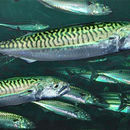Diseases and Parasites
provided by Fishbase
Ichthyophonus Disease. Fungal diseases
Trophic Strategy
provided by Fishbase
Mesodemersal. Abundant in cold and temperate shelf areas, forms large schools near the surface. They overwinter in deeper waters but move closer to shore in spring when water temperatures range between 11° and 14°C. Mainly diurnal, it feeds on zooplankton and small fish. In spring, the diet of the juveniles consisted of euphausiids, crustacean larvae and other zooplankton, whereas euphausiids formed 90% of the diet in adults (Ref. 55912). In autumn, juveniles ate hyperiids and gelatinous zooplankton, adults feed on blue whiting (Ref. 55912). Preyed upon by porbeagles, dogfish, Atlantic cod, bluefin tuna, swordfish, porpoises and harbour seals. Parasites of the species include monogenean, Kuhnia scombri on gills; trematodes, Podocotyle atomon and P. simplex; and nematodes, Anisakis simplex and Haematractidium scombri (Ref. 5951).
Morphology
provided by Fishbase
Dorsal spines (total): 8 - 14; Dorsal soft rays (total): 113; Analspines: 1; Analsoft rays: 12 - 13; Vertebrae: 31
Migration
provided by Fishbase
Oceanodromous. Migrating within oceans typically between spawning and different feeding areas, as tunas do. Migrations should be cyclical and predictable and cover more than 100 km.
Diseases and Parasites
provided by Fishbase
Coccidiosis. Parasitic infestations (protozoa, worms, etc.)
Diseases and Parasites
provided by Fishbase
Mycobacteriosis. Bacterial diseases
Diseases and Parasites
provided by Fishbase
Thynnascaris Disease. Parasitic infestations (protozoa, worms, etc.)
Diseases and Parasites
provided by Fishbase
Anisakis Disease. Parasitic infestations (protozoa, worms, etc.)
Diseases and Parasites
provided by Fishbase
Podocotyle simplex Disease. Parasitic infestations (protozoa, worms, etc.)
Diseases and Parasites
provided by Fishbase
Grillotia angeli Disease. Parasitic infestations (protozoa, worms, etc.)
Diseases and Parasites
provided by Fishbase
Opechona Disease. Parasitic infestations (protozoa, worms, etc.)
Diseases and Parasites
provided by Fishbase
Lecithocladium Disease. Parasitic infestations (protozoa, worms, etc.)
Diseases and Parasites
provided by Fishbase
Mazocraes Disease. Parasitic infestations (protozoa, worms, etc.)
Diseases and Parasites
provided by Fishbase
Kuhnia Disease. Parasitic infestations (protozoa, worms, etc.)
Diseases and Parasites
provided by Fishbase
Haemormidium Disease. Parasitic infestations (protozoa, worms, etc.)
Diagnostic Description
provided by Fishbase
This species has the following characters: no well developed corselet; interpelvic process small and single; anal fin spine conspicuous, joined to the fin by a membrane but clearly independent of it; anal fin origin opposite that of second dorsal fin; no swim bladder; first haemal spine anterior to first interneural process; 21-28 interneural bones under first dorsal fin; markings on back oblique to near vertical, with relatively little undulating; belly unmarked (Ref. 168).
Biology
provided by Fishbase
Abundant in cold and temperate shelf areas, forms large schools near the surface. They overwinter in deeper waters but move closer to shore in spring when water temperatures range between 11° and 14°C. Mainly diurnal, it feeds on zooplankton and small fish. Eggs and larvae are pelagic (Ref. 6769). Batch spawner (Ref. 51846). The species is traded fresh, frozen, smoked and canned. Eaten fried, broiled and baked (Ref. 9988). Two stocks in north-east Atlantic: North Sea (east) and British Isles (west). North Sea stock decreased dramatically in the 1960's because of direct overfishing. Recruitment has been poor and unstable. After spawning, the adult feed very actively moving around in small shoals (Ref. 35388).
Importance
provided by Fishbase
fisheries: highly commercial; gamefish: yes; price category: medium; price reliability: reliable: based on ex-vessel price for this species

